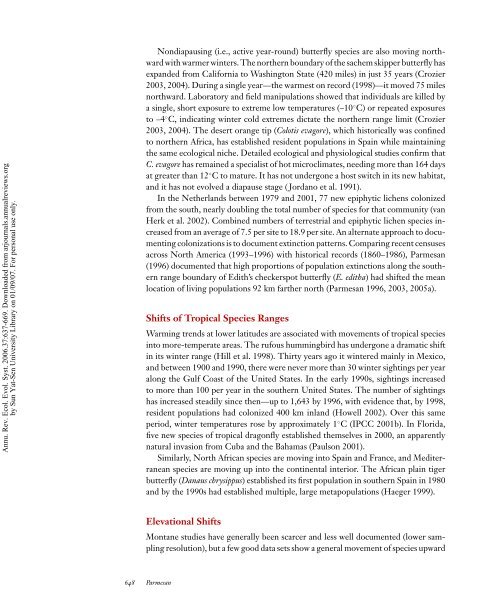Ecological and Evolutionary Responses to Recent Climate Change
Ecological and Evolutionary Responses to Recent Climate Change
Ecological and Evolutionary Responses to Recent Climate Change
You also want an ePaper? Increase the reach of your titles
YUMPU automatically turns print PDFs into web optimized ePapers that Google loves.
Annu. Rev. Ecol. Evol. Syst. 2006.37:637-669. Downloaded from arjournals.annualreviews.org<br />
by Sun Yat-Sen University Library on 01/09/07. For personal use only.<br />
Nondiapausing (i.e., active year-round) butterfly species are also moving northward<br />
with warmer winters. The northern boundary of the sachem skipper butterfly has<br />
exp<strong>and</strong>ed from California <strong>to</strong> Washing<strong>to</strong>n State (420 miles) in just 35 years (Crozier<br />
2003, 2004). During a single year—the warmest on record (1998)—it moved 75 miles<br />
northward. Labora<strong>to</strong>ry <strong>and</strong> field manipulations showed that individuals are killed by<br />
a single, short exposure <strong>to</strong> extreme low temperatures (–10 ◦ C) or repeated exposures<br />
<strong>to</strong> –4 ◦ C, indicating winter cold extremes dictate the northern range limit (Crozier<br />
2003, 2004). The desert orange tip (Colotis evagore), which his<strong>to</strong>rically was confined<br />
<strong>to</strong> northern Africa, has established resident populations in Spain while maintaining<br />
the same ecological niche. Detailed ecological <strong>and</strong> physiological studies confirm that<br />
C. evagore has remained a specialist of hot microclimates, needing more than 164 days<br />
at greater than 12 ◦ C <strong>to</strong> mature. It has not undergone a host switch in its new habitat,<br />
<strong>and</strong> it has not evolved a diapause stage ( Jordano et al. 1991).<br />
In the Netherl<strong>and</strong>s between 1979 <strong>and</strong> 2001, 77 new epiphytic lichens colonized<br />
from the south, nearly doubling the <strong>to</strong>tal number of species for that community (van<br />
Herk et al. 2002). Combined numbers of terrestrial <strong>and</strong> epiphytic lichen species increased<br />
from an average of 7.5 per site <strong>to</strong> 18.9 per site. An alternate approach <strong>to</strong> documenting<br />
colonizations is <strong>to</strong> document extinction patterns. Comparing recent censuses<br />
across North America (1993–1996) with his<strong>to</strong>rical records (1860–1986), Parmesan<br />
(1996) documented that high proportions of population extinctions along the southern<br />
range boundary of Edith’s checkerspot butterfly (E. editha) had shifted the mean<br />
location of living populations 92 km farther north (Parmesan 1996, 2003, 2005a).<br />
Shifts of Tropical Species Ranges<br />
Warming trends at lower latitudes are associated with movements of tropical species<br />
in<strong>to</strong> more-temperate areas. The rufous hummingbird has undergone a dramatic shift<br />
in its winter range (Hill et al. 1998). Thirty years ago it wintered mainly in Mexico,<br />
<strong>and</strong> between 1900 <strong>and</strong> 1990, there were never more than 30 winter sightings per year<br />
along the Gulf Coast of the United States. In the early 1990s, sightings increased<br />
<strong>to</strong> more than 100 per year in the southern United States. The number of sightings<br />
has increased steadily since then—up <strong>to</strong> 1,643 by 1996, with evidence that, by 1998,<br />
resident populations had colonized 400 km inl<strong>and</strong> (Howell 2002). Over this same<br />
period, winter temperatures rose by approximately 1 ◦ C (IPCC 2001b). In Florida,<br />
five new species of tropical dragonfly established themselves in 2000, an apparently<br />
natural invasion from Cuba <strong>and</strong> the Bahamas (Paulson 2001).<br />
Similarly, North African species are moving in<strong>to</strong> Spain <strong>and</strong> France, <strong>and</strong> Mediterranean<br />
species are moving up in<strong>to</strong> the continental interior. The African plain tiger<br />
butterfly (Danaus chrysippus) established its first population in southern Spain in 1980<br />
<strong>and</strong> by the 1990s had established multiple, large metapopulations (Haeger 1999).<br />
Elevational Shifts<br />
Montane studies have generally been scarcer <strong>and</strong> less well documented (lower sampling<br />
resolution), but a few good data sets show a general movement of species upward<br />
648 Parmesan
















